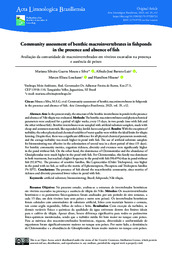Community assessment of benthic macroinvertebrates in fishponds in the presence and absence of fish.
Community assessment of benthic macroinvertebrates in fishponds in the presence and absence of fish.
Author(s): SILVA, M. S. G. M. e; LUIZ, A. J. B.; LOSEKANN, M. E.; HISANO, H.
Summary: Abstract Aim In the present study, the structure of the benthic invertebrates in ponds in the presence and absence of Nile tilapia was evaluated. Methods The benthic macroinvertebrates and physicochemical parameters were analyzed for a period of eight weeks, every 15 days, in two ponds (one with fish and the other without fish). Benthic invertebrates were sampled with artificial substrate samplers, made with cheap and common materials, like expanded clay, loofah leaves and gravel. Results With the exception of turbidity, the other physical and chemical variables of water quality were within the ideal limits for tilapia farming. Despite that, there was a significant difference for all physical-chemical parameters monitored, and the average turbidity was much higher in pond with fish. The use of artificial substrate samplers for biomonitoring was effective in the colonization of several taxa in a short period of time (15 days). For benthic community metrics, organism richness, diversity and evenness were significantly higher in the pond without fish. On the other hand, the dominance of Chironomidae and the abundance of Glossiphonidae were much higher in the pond with fish. For Chironomidae, this family was dominant in both treatments, but reached a higher frequency in the pond with fish (98.49%) than in pond without fish (92.87%). The presence of sensitive families, like Leptoceridae (Order Trichoptera), was higher in the pond with no fish, as well as the metric of Ephemeroptera, Plecoptera and Trichoptera families (% EPT). Conclusions The presence of fish altered the macrobenthic community, since metrics of richness and diversity presented lower values in pond with fish.
Publication year: 2023
Types of publication: Journal article
Unit: Embrapa Environment
Observation
Some of Embrapa's publications are published as ePub files. To read them, use or download one of the following free software options to your computer or mobile device. Android: Google Play Books; IOS: iBooks; Windows and Linux: Calibre.
Access other publications
Access the Agricultural Research Database (BDPA) to consult Embrapa's full library collection and records.
Visit Embrapa Bookstore to purchase books and other publications sold by Embrapa.

